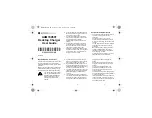
Product Safety Information
975-1175-01-01
vii
DANGER
HAZARD OF ELECTRIC SHOCK, EXPLOSION, OR ARC
FLASH
n
Apply appropriate personal protective equipment (PPE) and follow safe
electrical work practices. See NFPA 70E or CSA Z462.
n
This equipment must only be installed and serviced by qualified electrical
personnel.
n
Turn off all power supplying this equipment before working on or inside
equipment.
n
Always use a properly rated voltage sensing device to confirm power is
off.
n
Replace all devices, doors, and covers before turning on power to this
equipment.
n
Batteries can present a risk of electric shock, high short-circuit current
and exposure to gases and chemicals.
n
The following precautions must be observed when working with
batteries:
n
Remove watches, rings or other metal objects.
n
Keep sparks and flames away from batteries.
n
Use tools with insulated handles.
n
Do not lay tools or other metal parts on top of batteries.
n
Servicing of batteries must only be performed by qualified personnel
knowledgeable of batteries and the required precautions. Keep
unqualified personnel away from batteries.
n
Disconnect the charging source prior to connecting or disconnecting
battery terminals.
n
Never attempt to charge a frozen battery.
Failure to follow these instructions will result in death or serious
injury.
WARNING
FIRE AND EXPLOSION HAZARD
n
Unit’s components may produce arcs or sparks.
n
Do not install near batteries, in machinery space, or in an
area in which ignition-protected equipment is required. For
indoor use only.
Failure to follow these instructions can result in death, serious
injury, or equipment damage
.
Areas include any space containing gasoline-powered machinery,
fuel tanks, as well as joints, fittings, or other connections between
components of the fuel system.
WARNING
ELECTRICAL SHOCK HAZARD
n
Replace the wiring compartment cover before turning on
power to this equipment.
n
Use a torque screwdriver to tighten the captive nut panel
screw to 5 in-lb (0.56 N-m) torque to ensure a proper
ground connection and a required tool access to the wiring
compartment.
Failure to follow these instructions can result in death, serious
injury, or equipment damage
.








































